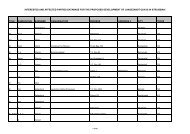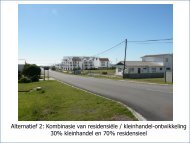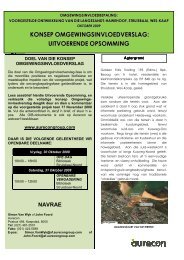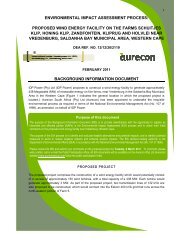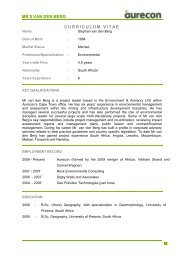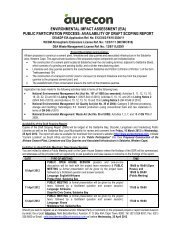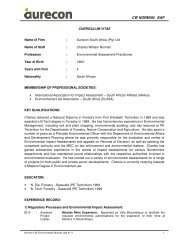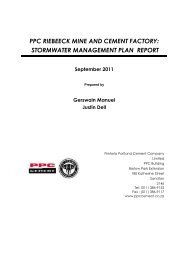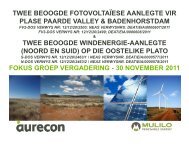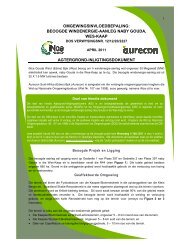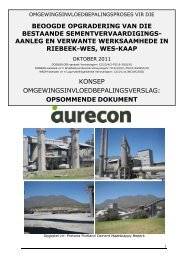Final EIAR - Aurecon AME Environmental | Environmental Projects
Final EIAR - Aurecon AME Environmental | Environmental Projects
Final EIAR - Aurecon AME Environmental | Environmental Projects
Create successful ePaper yourself
Turn your PDF publications into a flip-book with our unique Google optimized e-Paper software.
Proposed Wind and Solar (Photovoltaic) Energy Facilities on Kangnas Farm near Springbok in the Northern Cape: <strong>Final</strong> EIR 2<br />
The minimum size for a wind project at the Kangnas site, which would be competitive and affordable<br />
and hence a viable option for DoE to select, would be 280 MW, thus two of the proposed four phases.<br />
Phase A and B would be preferred by the developer due to the superior resource and limited<br />
environmental impacts of these phases.<br />
The minimum size for a solar project at the Kangnas site, which would be competitive and affordable<br />
and hence a viable option for DoE to select, would be 225 MW, thus all three of the proposed phases.<br />
It should be noted that Eskom’s current future planning for the Nama/Aggeneys 220 kV line is to<br />
upgrade to 400 kV. Should Eskom embark on the 400 kV upgrade in the near future all four phases<br />
(560 MW) of the proposed Kangnas wind farm would be required in order for the project to be<br />
affordable.<br />
The proposed wind and solar energy facilities and associated substations are located approximately<br />
48 km east of Springbok in the Northern Cape and can be accessed via the N14 as illustrated in<br />
Figure 1.1. <strong>Aurecon</strong> South Africa (Pty) Ltd (<strong>Aurecon</strong>) has been appointed to undertake the requisite<br />
environmental process as required in terms of the National <strong>Environmental</strong> Management Act (No. 107<br />
of 1998), as amended, on behalf of Mainstream.<br />
In terms of the National <strong>Environmental</strong> Management Act (No. 107 of 1998) (as amended) (NEMA),<br />
the proposed projects trigger a suite of activities, which require authorisation from the competent<br />
environmental authority before they can be undertaken. As these proposed projects trigger a number<br />
of listed activities in terms of NEMA, they accordingly require environmental authorisation. Since the<br />
projects are for the generation of energy, and energy projects are dealt with by the national authority,<br />
the competent authority is the national Department of <strong>Environmental</strong> Affairs (DEA). DEA’s decision<br />
will be based on the outcome of this EIA process.<br />
This report serves to document the EIA Phase of the EIA process (the EIA process and sequence of<br />
documents produced as a result of the process are illustrated in Figure 1.2).<br />
The EIA Phase is the last phase in the EIA process. Accordingly, this EIA Report (EIR) 1 aims to<br />
collate, synthesise and analyse information from a range of sources to provide sufficient information<br />
for DEA to make an informed decision on whether or not the potential environmental impacts<br />
associated with the proposed project are acceptable from an environmental perspective (the EIA<br />
process and sequence of documents produced as a result of the process are illustrated in Figure<br />
1.2).<br />
1 Section 31 of EIA Regulation No. 543 of NEMA lists the content required in an EIR.<br />
© <strong>Aurecon</strong> (2012) No unauthorised reproduction, copy<br />
or adaptation, in whole or in part, may be made.<br />
P:\<strong>Projects</strong>\108495 Kangnas WEF & PV EIA's\3 Project Delivery\4 Reports\FEIR\FEIR 210213 <strong>Final</strong>.doc


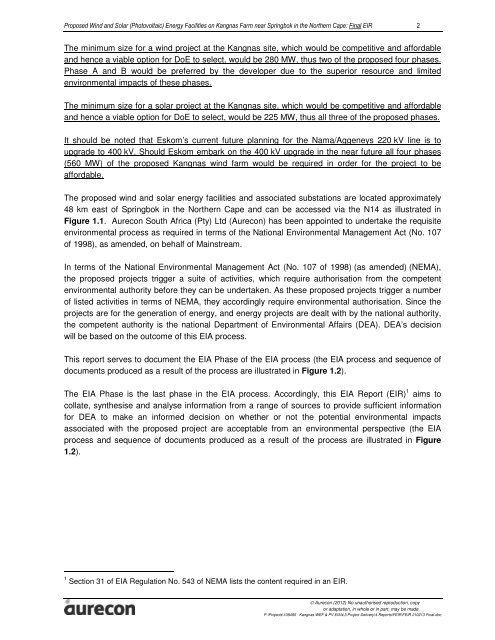
![CRR IV FEIR ~ 26042010 [FINAL].pdf - Environmental Projects](https://img.yumpu.com/21973020/1/184x260/crr-iv-feir-26042010-finalpdf-environmental-projects.jpg?quality=85)
